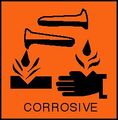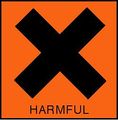Difference between revisions of "MSDS - Potassium hydroxide"
(Created page with " <gallery widths="120px" heights="120px" perrow="2" align="left"> File: Symbol - corrosive.jpg File:Symbol - harmful.jpg </gallery> <br> <br> <br> <br> <br> <br> <br> <br> P...") |
m (moved MSDS - Potassium Hydroxide to MSDS - Potassium hydroxide) |
||
| (2 intermediate revisions by one other user not shown) | |||
| Line 1: | Line 1: | ||
| − | |||
| − | |||
<gallery widths="120px" heights="120px" perrow="2" align="left"> | <gallery widths="120px" heights="120px" perrow="2" align="left"> | ||
File: Symbol - corrosive.jpg | File: Symbol - corrosive.jpg | ||
| Line 37: | Line 35: | ||
<td>Properties</td> | <td>Properties</td> | ||
<td> | <td> | ||
| − | *Form: White semi-transparent flaky solid | + | *Form: White semi-transparent flaky solid. |
*Stability: Stable, but hygroscopic. Absorbs carbon dioxide from the air. | *Stability: Stable, but hygroscopic. Absorbs carbon dioxide from the air. | ||
| − | *Melting point: | + | *Melting point: 360°C |
| − | *Water solubility: high (dissolution is very exothermic) | + | *Water solubility: high (dissolution is very exothermic). |
*Specific gravity: 2.04 | *Specific gravity: 2.04 | ||
</tr> | </tr> | ||
| Line 46: | Line 44: | ||
<td>Principal hazards</td> | <td>Principal hazards</td> | ||
<td> | <td> | ||
| − | *Contact with the eyes can cause serious long-term damage | + | *Contact with the eyes can cause serious long-term damage. |
| − | *The solid and its solutions are corrosive | + | *The solid and its solutions are corrosive. |
| − | *A significant amount of heat is released when potassium hydroxide dissolves in water; this may be sufficient to crack thin glassware if the solution is not stirred when dissolving the solid | + | *A significant amount of heat is released when potassium hydroxide dissolves in water; this may be sufficient to crack thin glassware if the solution is not stirred when dissolving the solid. |
</td> | </td> | ||
</tr> | </tr> | ||
| Line 63: | Line 61: | ||
*Eye contact: Immediately flush the eye with plenty of water. Continue for at least ten minutes and call for immediate medical help. | *Eye contact: Immediately flush the eye with plenty of water. Continue for at least ten minutes and call for immediate medical help. | ||
*Skin contact: Wash off with plenty of water. Remove any contaminated clothing. If the skin reddens or appears damaged, call for medical aid. | *Skin contact: Wash off with plenty of water. Remove any contaminated clothing. If the skin reddens or appears damaged, call for medical aid. | ||
| − | If swallowed: Drink plenty of water and call for immediate medical help. | + | *If swallowed: Drink plenty of water and call for immediate medical help. |
</td> | </td> | ||
</tr> | </tr> | ||
| Line 70: | Line 68: | ||
<td> | <td> | ||
*Small amounts of dilute potassium hydroxide can be flushed down a sink with a large quantity of water, unless local rules prohibit this. | *Small amounts of dilute potassium hydroxide can be flushed down a sink with a large quantity of water, unless local rules prohibit this. | ||
| − | *Larger amounts should be neutralised before disposal | + | *Larger amounts should be neutralised before disposal.</td> |
</tr> | </tr> | ||
<tr> | <tr> | ||
| Line 80: | Line 78: | ||
<tr> | <tr> | ||
<td> Further information </td> | <td> Further information </td> | ||
| − | <td>[http:// | + | <td>[http://msds.chem.ox.ac.uk/PO/potassium_hydroxide.html More extensive safety data]</td> |
</tr> | </tr> | ||
</table> | </table> | ||
Latest revision as of 21:14, 20 February 2013
Potassium Hydroxide material data safety sheet. Reproduced with kind permission of the Department of Chemistry, Oxford University.
Last updated January 18, 2007
| Common synonyms |
|
| Formula | KOH |
| Properties |
|
| Principal hazards |
|
| Safe handling |
|
| Emergency |
|
| Disposal |
|
| Protective equipment |
|
| Further information | More extensive safety data |
Bio-rich-time-poor 21:07, 25 June 2011 (BST)

